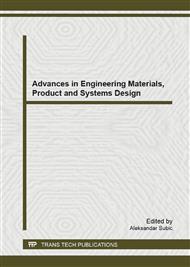[1]
Y. Li, B.V. Holcombe, Mathematical Simulation of Heat and Moisture Transfer in Human-Clothing-Environment System, Text. Res. J. 68(6) (1998) 389-397.
DOI: 10.1177/004051759806800601
Google Scholar
[2]
Y. Li, The Science of Clothing Comfort, Textile Progress. Vol. 31, The Textile Institute, UK, (2001).
Google Scholar
[3]
R. Rossi., Interaction between protection and thermal comfort, in: R. A. Scott (Eds. ) Textiles for protection, Woodhead Publishing Ltd., Cambridge, UK, 2005, pp.233-240.
Google Scholar
[4]
G.S. Chung , D.H. Lee, A study on comfort of protective clothing for firefighters, in: T. Yutaka O. Tadakatsu (Eds. ), Elsevier Ergonomics Book Series, Elsevier, 2005. pp.375-378.
DOI: 10.1016/s1572-347x(05)80059-x
Google Scholar
[5]
S.S. Cheungi, S.R. Petersen, T.M. Mclellan, Physiological strain and countermeasure with firefighting, Scandinavian J. of Medicine & Science in Sports. 3 (2010) 103-116.
DOI: 10.1111/j.1600-0838.2010.01215.x
Google Scholar
[6]
D.A. Torvi, Heat transfer in thin fibrous materials under high heat flux conditions, Department of Mechanical Engineering, Doctoral Thesis, University of Alberta Canada (1997).
Google Scholar
[7]
G. Song, R.L. Barker, H. Hamouda, A.V. Kuznetsov, P. Chitrphiromsri, R.V. Grimes., Modeling the Thermal Protective Performance of Heat Resistant Garments in Flash Fire Exposures, Text. Res. J. 74(12) (2004) 1033-1040.
DOI: 10.1177/004051750407401201
Google Scholar
[8]
ISO 6942-2002, Protective clothing - Protection against heat and fire - Method of test: Evaluation of materials and material assemblies when exposed to a source of radiant heat. © ISO, (2002).
DOI: 10.3403/02592097u
Google Scholar
[9]
ISO 9151- 1995, Protective clothing against heat and flame - Determination of heat transmission on exposure to flame. © ISO, (1995).
DOI: 10.3403/30273152u
Google Scholar
[10]
ISO 11092-1993, Textiles - Physiological effects- Measurements of thermal and vapour resistance under steady-state conditions sweating guarded hot plate. © ISO, (1993).
DOI: 10.3403/30296435u
Google Scholar
[11]
Y. Cheng, J. Niu, N. Gao, Thermal comfort models: A review and numerical investigation, Building and Environment, 47 (2012) 13-22.
DOI: 10.1016/j.buildenv.2011.05.011
Google Scholar
[12]
E. Foda, I. Almesri, H. B. Awbi, K. Sirén, Models of human thermoregulation and the prediction of local and overall thermal sensations, Building and Environment. 46 (2011) 2023-(2032).
DOI: 10.1016/j.buildenv.2011.04.010
Google Scholar
[13]
B. Hoschke, Standards and specifications for firefighters' clothing, Fire safety J. 4 (1981) 125-137.
DOI: 10.1016/0379-7112(81)90011-4
Google Scholar
[14]
J.M. Stapleton, H.E. Wright, S. G. Hardcastle, G.P. Kenny, Body heat storage during intermittent work in hot–dry and warm–wet environments, J. Appl. Physio. Nutr. Metab. 37(5) (2012) 840 - 849.
DOI: 10.1139/h2012-053
Google Scholar
[15]
AS 2001. 2. 13 - 1987, Methods of test for textiles - Physical tests - Determination of mass per unit area and mass per unit length of fabric. Standards Australia, (1987).
DOI: 10.3403/01411761u
Google Scholar
[16]
AS 2001. 2. 15 - 1989, Methods of test for textiles - Physical tests - Determination of thickness of textile fabrics. Standards Australia, (1989).
Google Scholar
[17]
AS 2001. 2. 5 - 1991, Methods of test for textiles - Physical tests - Determination of the number of threads per unit length in woven fabric. Standards Australia, (1991).
DOI: 10.3403/00326010
Google Scholar
[18]
ISO 9237 - 1995, Textiles – Determination of the permeability of fabrics to air. (1995).
Google Scholar
[19]
AATCC Test method 195-2011, Liquid Moisture Management Properties of Textile Fabrics. (2009).
Google Scholar
[20]
J. Hu, Y. Li, K.W. Yeung, A.S.W. Wong, W. Xu, , Moisture Management Tester: A Method to Characterize Fabric Liquid Moisture Management Properties. Text. Res. J. 75 (1) (2005) 57-62.
DOI: 10.1177/004051750507500111
Google Scholar
[21]
B-g. Yao, Y. Li, J. Hu, Y. Kwok, K. Yeung, An improved test method for characterizing the dynamic liquid moisture transfer in porous polymeric materials, Poly. Testing. 25(5) (2006) 677 689.
DOI: 10.1016/j.polymertesting.2006.03.014
Google Scholar
[22]
ISO 11092 - 1993, Textiles – Physiological effects – Measurement of thermal and water vapour resistance under steady-state conditions sweating guarded-hotplate test. (1993).
DOI: 10.3403/30296435u
Google Scholar
[23]
A.S. Wong, Y. Li, K.W. Yeung, Performances of artificial intelligence hybrid models' in prediction of clothing comfort from fabric physical properties, Sen-i Gakkaishi, The Society of Fibre Science and Technology, Japan, 59 (11) (2003) 429-436.
DOI: 10.2115/fiber.59.429
Google Scholar
[24]
D. Fiala, K. Lomas, M. Stohrer, A Computer model of human thermoregulation for A wide range of environment al conditions: passive system. J. Appl. Physiol. 87 (5) (1999) 1957- (1972).
DOI: 10.1152/jappl.1999.87.5.1957
Google Scholar
[25]
I. Yermakova, V. Candas, Practical use of thermal model for evaluation of human state in hot environment: summary of French-Ukrainian project, ICEE Х11, Ljubliana (2007) 468-471.
Google Scholar
[26]
V. Candas, I. Yermakova, Computer simulation of human physical activity in moderate heat, Manikins and Modelling, Coimbra, Portugal, Ed. M. Silva (2008).
Google Scholar
[27]
D. A. Torvi, J.D. Dale, B. Faulkner, Influence of Air Gaps on Bench-top Test Results of Flame Resistant Fabrics, J. Fire Pro. 10 (1) (1999) 1-12.
DOI: 10.1177/104239159901000101
Google Scholar
[28]
J. F. Krasny, Some characteristics of fabrics for heat protective garments, in: R.L. Barker, G.C. Coletta, G. C., (Eds. ) Performance of Protective Clothing, American Society for Testing and Materials, Philadelphia (1986463–474.
DOI: 10.1520/stp17335s
Google Scholar
[29]
Y.S. Chen, J. Fan., X. Qian, W. Zhang, Effect of Garment Fit on Thermal Insulation and Evaporative Resistance, Text. Res. J. 74(8) (2004) 742-748.
DOI: 10.1177/004051750407400814
Google Scholar
[30]
[TC]² 2010, 3D Body Scanning & Technology Development, viewed July 2011. Available from: http: /www. tc2. com/index_3dbodyscan. htm.
Google Scholar


